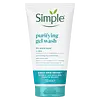What's inside
What's inside
 Key Ingredients
Key Ingredients

 Benefits
Benefits

 Concerns
Concerns

 Ingredients Side-by-side
Ingredients Side-by-side

Water
Skin ConditioningHamamelis Virginiana Leaf Water
AstringentCocamidopropyl Betaine
CleansingGlycerin
HumectantSodium Laureth Sulfate
CleansingPEG-7 Glyceryl Cocoate
EmulsifyingAcrylates/C10-30 Alkyl Acrylate Crosspolymer
Emulsion StabilisingBenzophenone-4
UV AbsorberCitric Acid
BufferingHydrated Silica
AbrasiveHydroxypropyl Cyclodextrin
MaskingIodopropynyl Butylcarbamate
PreservativeNiacinamide
SmoothingPanthenol
Skin ConditioningPantolactone
HumectantPhenoxyethanol
PreservativePotassium Sorbate
PreservativeSodium Benzoate
MaskingSodium Chloride
MaskingSodium Hydroxide
BufferingThymus Vulgaris Flower/Leaf Extract
MaskingXanthan Gum
EmulsifyingZinc PCA
HumectantWater, Hamamelis Virginiana Leaf Water, Cocamidopropyl Betaine, Glycerin, Sodium Laureth Sulfate, PEG-7 Glyceryl Cocoate, Acrylates/C10-30 Alkyl Acrylate Crosspolymer, Benzophenone-4, Citric Acid, Hydrated Silica, Hydroxypropyl Cyclodextrin, Iodopropynyl Butylcarbamate, Niacinamide, Panthenol, Pantolactone, Phenoxyethanol, Potassium Sorbate, Sodium Benzoate, Sodium Chloride, Sodium Hydroxide, Thymus Vulgaris Flower/Leaf Extract, Xanthan Gum, Zinc PCA
Water
Skin ConditioningAmmonium Lauryl Sulfate
CleansingCitrus Limon Fruit Extract
MaskingCocamidopropyl Betaine
CleansingSodium Cocoyl Glutamate
CleansingDisodium Cocoyl Glutamate
CleansingGlycerin
HumectantHoney
HumectantAcrylates/C10-30 Alkyl Acrylate Crosspolymer
Emulsion StabilisingParfum
MaskingPhenoxyethanol
PreservativeSodium Hydroxide
BufferingHydrogenated Jojoba Oil
AbrasiveCitric Acid
BufferingSodium Metabisulfite
AntioxidantMethylchloroisothiazolinone
PreservativeDisodium EDTA
Water, Ammonium Lauryl Sulfate, Citrus Limon Fruit Extract, Cocamidopropyl Betaine, Sodium Cocoyl Glutamate, Disodium Cocoyl Glutamate, Glycerin, Honey, Acrylates/C10-30 Alkyl Acrylate Crosspolymer, Parfum, Phenoxyethanol, Sodium Hydroxide, Hydrogenated Jojoba Oil, Citric Acid, Sodium Metabisulfite, Methylchloroisothiazolinone, Disodium EDTA
 Reviews
Reviews

Ingredients Explained
These ingredients are found in both products.
Ingredients higher up in an ingredient list are typically present in a larger amount.
Acrylates/C10-30 Alkyl Acrylate Crosspolymer is a synthetic polymer. It is used to thicken and improve the texture of products. Due to its properties, it can prevent water and oil ingredients from separating.
Citric Acid is an alpha hydroxy acid (AHA) naturally found in citrus fruits like oranges, lemons, and limes.
Like other AHAs, citric acid can exfoliate skin by breaking down the bonds that hold dead skin cells together. This helps reveal smoother and brighter skin underneath.
However, this exfoliating effect only happens at high concentrations (20%) which can be hard to find in cosmetic products.
Due to this, citric acid is usually included in small amounts as a pH adjuster. This helps keep products slightly more acidic and compatible with skin's natural pH.
In skincare formulas, citric acid can:
While it can provide some skin benefits, research shows lactic acid and glycolic acid are generally more effective and less irritating exfoliants.
Most citric acid used in skincare today is made by fermenting sugars (usually from molasses). This synthetic version is identical to the natural citrus form but easier to stabilize and use in formulations.
Read more about some other popular AHA's here:
Learn more about Citric AcidCocamidopropyl Betaine is a fatty acid created by mixing similar compounds in coconut oil and dimethylaminopropylamine, a compound with two amino groups.
This ingredient is a surfactant and cleanser. It helps gather the dirt, pollutants, and other impurities in your skin to be washed away. It also helps thicken a product and make the texture more creamy.
Being created from coconut oil means Cocamidopropyl Betaine is hydrating for the skin.
While Cocamidopropyl Betaine was believed to be an allergen, a study from 2012 disproved this. It found two compounds in unpure Cocamidopropyl Betaine to be the irritants: aminoamide and 3-dimethylaminopropylamine. High-grade and pure Cocamidopropyl Betaine did not induce allergic reactions during this study.
Learn more about Cocamidopropyl BetaineGlycerin is already naturally found in your skin. It helps moisturize and protect your skin.
A study from 2016 found glycerin to be more effective as a humectant than AHAs and hyaluronic acid.
As a humectant, it helps the skin stay hydrated by pulling moisture to your skin. The low molecular weight of glycerin allows it to pull moisture into the deeper layers of your skin.
Hydrated skin improves your skin barrier; Your skin barrier helps protect against irritants and bacteria.
Glycerin has also been found to have antimicrobial and antiviral properties. Due to these properties, glycerin is often used in wound and burn treatments.
In cosmetics, glycerin is usually derived from plants such as soybean or palm. However, it can also be sourced from animals, such as tallow or animal fat.
This ingredient is organic, colorless, odorless, and non-toxic.
Glycerin is the name for this ingredient in American English. British English uses Glycerol/Glycerine.
Learn more about GlycerinPhenoxyethanol is a preservative that has germicide, antimicrobial, and aromatic properties. Studies show that phenoxyethanol can prevent microbial growth. By itself, it has a scent that is similar to that of a rose.
It's often used in formulations along with Caprylyl Glycol to preserve the shelf life of products.
Sodium Hydroxide is also known as lye or caustic soda. It is used to adjust the pH of products; many ingredients require a specific pH to be effective.
In small amounts, sodium hydroxide is considered safe to use. However, large amounts may cause chemical burns due to its high alkaline.
Your skin has a natural pH and acid mantle. This acid mantle helps prevent harmful bacteria from breaking through. The acid mantle also helps keep your skin hydrated.
"Alkaline" refers to a high pH level. A low pH level would be considered acidic.
Learn more about Sodium HydroxideWater. It's the most common cosmetic ingredient of all. You'll usually see it at the top of ingredient lists, meaning that it makes up the largest part of the product.
So why is it so popular? Water most often acts as a solvent - this means that it helps dissolve other ingredients into the formulation.
You'll also recognize water as that liquid we all need to stay alive. If you see this, drink a glass of water. Stay hydrated!
Learn more about Water